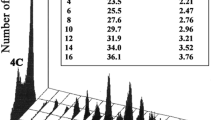Abstract
The physiological and pathological importance of cell death by apoptosis has recently been recognized. One of the hallmarks of apoptosis is the enzymatic cleavage of genomic DNA into nucleosomal oligomers. The identification of an endonuclease responsible for apoptosis might help to explain how this cell suicide is regulated and why DNA is cleaved. Here, we found that γ type of DNase was retained in apoptotic rat thymocyte nuclei. Homogeneously purified DNase γ (Mr = 33 kDa) from the apoptotic nuclei was revealed to be a Ca2+/Mg2+-dependent endonuclease and inhibited by Zn2+. This enzyme cleaved chromosomal DNA with 3′-hydroxyl (OH) and 5′-phosphoryl (P) ends. The cleavage ends and its divalent cation dependencies match those observed in apoptotic thymocytes induced by X-irradiation or glucocorticoid treatment, indicating that this endonuclease is a central component of the thymic apoptosis machinery.
Similar content being viewed by others
References
Kerr JFR, Wyllie AH, Currie AR. Apoptosis: a basic biological phenomenon with wide-ranging implications in tissue kinetics.Br J Cancer 1972;26: 239–257.
Umansky SR. The genetic program of cell death. Hypothesis and some applications: transformation, carcinogenesis, ageing.J Theor Biol 1982;97: 591–602.
Kappler JW, Roehm N, Marrack P. T cell tolerance by clonal elimination in the thymus.Cell 1987;49: 273–280.
Raff MC. Social controls on cell survival and cell death.Nature 1992;356: 397–400.
Cohen JJ. Exponential growth in apoptosis.Immunol Today 1993;14: 126–130.
Kelly KA, Pircher H, Boehmer H von, Davis MM, Scollay R. Regulation of T cell production in T cell receptor transgenic mice.Eur J Immun 1993;23: 1922–1928.
Surh CD, Sprent J. T-cell apoptosis detectedin situ during positive and negative selection in the thymusNature 1994;372: 100–103.
Tamuna S. Molecular mechanism of apoptosis In: Sluyser M, ed.Apoptosis in normal development and cancer. London: Taylor & Francis 1996: 39–59.
Levine AJ, Momzd J, Finlay CA. The p53 tumour suppressor gene.Nature 1991;351: 453–456.
Carson DA, Ribeiro JM. Apoptosis and disease.Lancet 1993;341: 1251–1254.
Gougeon ML, Montagnier L. Apoptosis in AIDS.Science 1993;260: 1269–1270.
Wyllie AH. Glucocorticoid-induced thymocyte apoptosis is associated with endogenous endonuclease activation.Nature 1980;284: 555–556.
Wyllie AH, Morris RG, Smith AL, Dunlop D. Chromatin cleavage in apoptosis: Association with condensed chromatinmorphology and dependence on macromolecular synthesis.J Pathol 1984;142: 67–77.
Arends MJ, Morris RG, Wyllie AH. Apoptosis. The role of the endonuclease.Am J Pathol 1990;136: 593–601.
Tanuma S, Shiokawa D. Multiple forms of nuclear deoxyribo-nuclease in rat thymocytes.Biochem Biophys Res Commun 1994;203: 789–797.
Cohen JJ, Duke RC. Glucocorticoid activation of a calcium-dependent endonuclease in thymocyte nuclei leads to cell death.J Immunol 1984;132: 38–42.
McConkey DJ, Hartzell P, Nicotera P, Orrenius S. Calcium-activated DNA fragmentation kills immature thymocytes.FASEB J 1989;3: 1843–1849.
Gaido ML, Cidlowski JA. Identification, purification, and characterization of a calcium-dependent endonuclease (NUC18) from apoptotic rat thymocytes.J Biol Chem 1991;266: 18580–18585.
Peitsch MC, Polzar B, Stepham H, Crompton T, MacDonald HR, Mannherz HG, Tshopp J. Characterization of the endogenous deoxyribonuclease involved in nuclear DNA degradation during apoptosis (programmed cell death).EMBOJ 1993;12: 371–377.
Barry MA, Eastman A. Identification of deoxyribonuclease II as an endonuclease involved in apoptosis.Arch Biochem Biophys 1993;300: 440–450.
Ribeiro JM, Carson DA. Ca2+/Mg2+-dependent endonuclease from human spleen: purification, properties, and in apoptosis.Biochemistry 1993;32: 9129–9136.
Nikonova LV, Belelsky IP, Umansky SR. Properties of some nuclear nucleases of rat thymocytes and their changes in radiation-induced apoptosis.Eur J Biochem 1993;215: 893–901.
Shiokawa D, Ohyama H, Yamada T, Takahashi K, Tanuma S. Identification of an endonuclease responsible for apoptosis in rat thymocytes.Eur J Biochem 1994;226: 23–30.
Peitsh MC, Mannherz HG, Tshopp J. The apoptosis endonucleases: Cleaning up after cell death?Trends Cell Biol 1994;4: 37–41.
Tanuma S. DNA fragmentation in apoptosis.Tissu Cult Res Commun 1995;14: 133–140.
Author information
Authors and Affiliations
Rights and permissions
About this article
Cite this article
Shiokawa, D., Nishimura, K., Maruta, H. et al. DNA fragmentation during thymic apoptosis is catalyzed by DNase γ. Apoptosis 1, 147–152 (1996). https://doi.org/10.1007/BF01321021
Received:
Accepted:
Issue Date:
DOI: https://doi.org/10.1007/BF01321021




